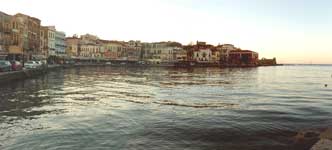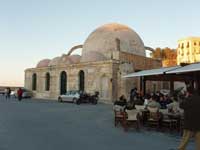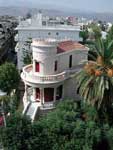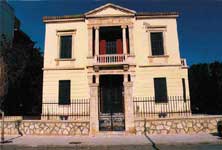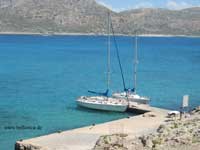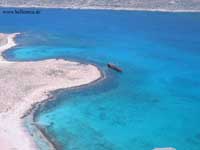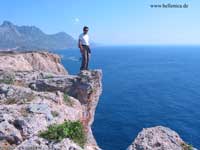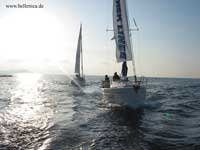.
Administrative Region : Crete
Regional unit : Chania
Chania (Greek: Χανιά (plural), [xaˈɲa], also transliterated Chania, Hania, and Xania, older form Chanea and Venetian Canea, Ottoman Turkish خانيه Hanya) is the second largest city of Crete and the capital of the Chania regional unit. It lies along the north coast of the island, about 70 km (43 mi) west of Rethymno and 145 km (90 mi) west of Heraklion.

Port of Chania, Photo : Jose Goncalves
The official population of the municipal unit (the former municipality) is 55,838, while its metropolitan area has 108,310 (2011) inhabitants. This consists of the city of Chania along with 7 towns and villages: Mournies (pop. 6,390), Souda (pop. 5,330), Nerokouros (pop. 4,175), Daratsos (pop. 3,287), Perivolia (pop. 3,065), Galatas (pop. 2,131) and Vamvakopoulo (pop. 1,769).
Geography
The city of Chania lies around 40 km (25 mi) from the west end of Crete. By road, the distance is approximately 52 km (32 mi).[1]
Chania, Greece

Climate
The city enjoys a typical Mediterranean climate, with sunny dry summers and mild rainy winters. During the period between April and October, clear-sky weather is almost an everyday feature. The atmosphere is always warm, but fierce heat waves (temperatures above 38 °C) are not very common, since the prevailing Etesian winds ("Meltemia") blow from northern directions and pleasantly moderate the conditions. Intervals of sunny days are frequent during the windy and rainy winter as well. Snow and frost are rare near the coast, with very few exceptions, like the snowstorm on 13 February 2004, when 10–30 in (250–760 mm) of snow accumulated in the urban area, causing general chaos. However, such cold days can be followed by much warmer and sunny weather. Even minor early heat waves can occur in March or April, during a Saharan dust event, whose main feature is the strong and hot katabatic wind from the south, which is a type of Sirokos (σιρόκος) and is called "Livas" (i.e. the wind from Libya) by the Greeks. Such events happen only a couple of times a year, and their duration is never more than one or two days.
The chart to the right is based on data recorded during 1958-1997. Absolute maximum temperature ever recorded was 42.5 °C, while absolute minimum ever recorded was 0 °C. However, the record minimum was broken on 13 February 2004 when the temperature reached -1 °C at midday.
| Climate data for Chania | |||||||||||||
|---|---|---|---|---|---|---|---|---|---|---|---|---|---|
| Month | Jan | Feb | Mar | Apr | May | Jun | Jul | Aug | Sep | Oct | Nov | Dec | Year |
| Average high °C (°F) | 14.4 (57.9) |
14.9 (58.8) |
16.6 (61.9) |
20.1 (68.2) |
24.4 (75.9) |
28.7 (83.7) |
30.3 (86.5) |
29.9 (85.8) |
27.3 (81.1) |
23.1 (73.6) |
19.6 (67.3) |
16.2 (61.2) |
22.13 (71.83) |
| Daily mean °C (°F) | 10.8 (51.4) |
11.1 (52.0) |
12.6 (54.7) |
15.8 (60.4) |
20.0 (68.0) |
24.4 (75.9) |
26.4 (79.5) |
25.8 (78.4) |
23.0 (73.4) |
19.0 (66.2) |
15.6 (60.1) |
12.6 (54.7) |
18.09 (64.57) |
| Average low °C (°F) | 7.5 (45.5) |
7.7 (45.9) |
8.6 (47.5) |
11.1 (52.0) |
14.5 (58.1) |
18.5 (65.3) |
20.6 (69.1) |
20.5 (68.9) |
18.2 (64.8) |
15.1 (59.2) |
11.9 (53.4) |
9.3 (48.7) |
13.63 (56.53) |
| Rainfall mm (inches) | 141.7 (5.579) |
112.4 (4.425) |
80.7 (3.177) |
31.8 (1.252) |
13.0 (0.512) |
4.6 (0.181) |
1.3 (0.051) |
1.5 (0.059) |
18.7 (0.736) |
80.1 (3.154) |
72.8 (2.866) |
93.9 (3.697) |
652.5 (25.689) |
| Avg. rainy days (≥ 1.0 mm) | 12.4 | 11.0 | 8.1 | 4.2 | 2.0 | 0.6 | 0.1 | 0.3 | 1.2 | 5.7 | 7.2 | 11.0 | 63.8 |
| Mean monthly sunshine hours | 117.8 | 127.1 | 176.7 | 231.0 | 303.8 | 342.0 | 375.1 | 359.6 | 288.0 | 195.3 | 153.0 | 120.9 | 2,790.3 |
| Source: Hong Kong Observatory.[2] | |||||||||||||
Municipality
|
|
|
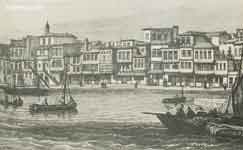
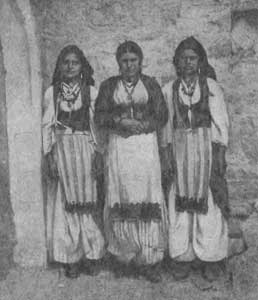
Women of Chania, c. 1897
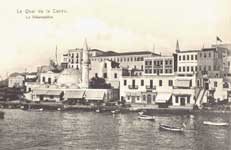
The municipality Chania was formed at the 2011 local government reform by the merger of the following 7 former municipalities, that became municipal units:[3]
Chania Venetian Harbour
Akrotiri
Chania
Eleftherios Venizelos
Keramia
Nea Kydonia
Souda
Theriso
History
Early history
Hellenistic head of a woman from the cemetery of ancient Kydonia in the Archaeological Museum of Chania.

1905, Theriso, Chania. Eleftherios Venizelos declares the revolution against the monarchy of Prince George
Chania is the site of the Minoan settlement the Greeks called Kydonia, Greek for quince. Some notable archaeological evidence for the existence of this Minoan city below some parts of today's Chania was found by excavations[4] in the district of Kasteli in the Old Town. This area appears to have been inhabited since the Neolithic era. The city reemerged after the end of the Minoan period as an important city-state in Classical Greece, one whose domain extended from Chania Bay to the feet of the White Mountains. The first major wave of settlers from mainland Greece was by the Dorian Greeks who came around 1100 BC. Kydonia was constantly at war with other Cretan city-states such as Aptera, Phalasarna and Polyrrinia and was important enough for the Kydonians to be mentioned in Homer's Odyssey (iii.330). In 69 BC, the Roman consul Caecilius Metellus defeated the Cretans and conquered Kydonia to which he granted the privileges of an independent city-state. Kydonia reserved the right to mint its own coins until the third century AD.
Byzantine Era
Further information: Byzantine Crete
The early Christian period under Byzantine rule (First Byzantine Period, 395–824 AD) and the rule of the Arabs, who called the settlement Al Hanim ("the Inn"), are not well documented. Under the Arabs, the Christian population was persecuted and moved to the mountains. The Byzantine Empire retook the city in 961 AD (Second Byzantine Period, until 1204 AD). In this period the Arabic name of the city was changed into Greek Chania. Byzantines began to strongly fortify the city in order to prevent another Arab invasion, using materials from the ancient buildings of the area. By this time Chania was the seat of a bishop.
The Venetian era
The old harbour during the Venetian era.
After the Fourth Crusade (1204) and the fall of Byzantium in the Hellenic area, Crete was given to Bonifacio, Marquess of Montferrat. He in turn chose to sell it to the Venetians for 100 silver marks. In 1252 the Venetians managed to subdue the Cretans but in 1263, their rivals of Genoa, with local support, seized the city under the leadership of Enrico Pescatore, count of Malta, and held it until 1285, when the Venetians returned. Chania was chosen as the seat of the Rector (Administrator General) of the region and flourished as a significant commercial centre of a fertile agricultural region.
The Venetian rule was initially strict and oppressive but slowly the relations between the two parts improved. Contact with Venice led to close intertwining of Cretan and Venetian cultures, without, however, the Cretans losing their Greek Orthodox nature. The city's name became La Canea and fortifications were strengthened, giving Chania the form that it still has today. On the other hand, after the fall of Constantinople in 1453, many priests, monks and artists took refuge in Crete and reinforced the Byzantine religion and culture on the island. The city of Chania during the period that followed was a blend of Byzantine, Venetian and Classical Greek cultural elements. Many of the important buildings of the town were built during this era and the intellectual activities (written word, music, education) were also promoted.
Ottoman Era
The old harbour during the Ottoman era.
Further information: Ottoman Crete
However, the walls did not prevent the Ottoman army from overrunning the city in 1645 after just two months' siege. The Ottomans landed near the Monastery of Gonia in Kissamos, which they plundered and burnt.[CN] They seized Chania itself on 2 August 1645. Huge numbers died in the siege, particularly Turks. The Ottoman commander was executed on returning home for losing up to 40,000 men. Later, most churches were turned into mosques. The Turks resided mainly in the eastern quarters, Kastelli and Splantzia, where they converted the Dominican church of St Nicholas into the central Sovereign's Mosque (Turkish: Hünkar Camısı). They also built new mosques such as the Küçük Hasan or Yali Mosque on the harbour. Public baths (hamam), and fountains were a feature of the Turkish city. The pasha of Crete resided in Chania.
In 1821, as Greeks rose against the Ottoman Empire, there were conflicts between Greeks and Turks in Chania, leading to casualties from both sides, most of whom were Muslims.[CN] The Bishop of Kissamos, Melhisedek Despotakis, was hanged from a tree in Splantzia for participation in the revolutionary events. In 1878, the Pact of Halepa was signed. This was when a big part of the local Muslim population was killed or moved to Turkey. There was no Muslim population left before the population exchange between Greece and Turkey in 1922.
Modern era
Further information: History of Modern Greece
Eleftherios Venizelos (1864–1936), major political figure of 20th century, was born in Chania.
In 1898, during the final moves towards independence and enosis — union with Greece — the Great Powers made Chania the capital of the semi-autonomous Cretan State ("Kritiki Politeia"), with Prince George of Greece, the High Commissioner of Crete living here. During these years Crete issued its own stamps and money. This was a very important transitional period when, no longer an isolated vilayet of the Ottoman Empire, the city became more cosmopolitan and flourishing, regaining its role as the crossroad of civilizations, influenced by Europe as well as by the East. Many important buildings were built during this era, intellectual and artistic societies were created and a new class of local aristocracy brought a different atmosphere to the everyday life of the town. The district of Halepa has many fine neoclassical embassies and consulates dating from this period.
However the main goal was enosis with Greece which came after Venizelos's constant opposition to Prince George's rule over Crete. The series of conflicts includes the Therisos revolt in 1905, which overthrew Prince George and brought Alexandros Zaimis to rule Crete. Finally in 1908 Venizelos managed to establish a revolutionary government, recognized by the Great Powers. His later election as the prime minister of Greece (1910) was the last step before Crete was united with Greece on 1 December 1913. The Greek flag was raised for the first time at Fort Firca in the Old Harbour in the presence of Eleftherios Venizelos and King Constantine.
Eleftherios Venizelos, who hailed from Mournies near Chania, was the leader of the 1896-97 uprising against Ottoman rule and went on to be Prime Minister of Greece and a great statesman. His tomb is on a hill overlooking Chania (Profitis Ilias, 35°31′29.5″N 24°03′22.2″E).
Chania in World War II
Further information: Axis occupation of Greece during World War II and Battle of Crete
Another important period for the city of Chania was the invasion and occupation by German forces during World War II. The British force that faced the German paratroopers during the Battle Of Crete in 1941, had artillery elements over the hill of Dexameni in the south of the city. These elements bombed the German forces in the Maleme airfield undetected, until they ran out of ammunition. George II of Greece stayed in a villa near the village of Perivolia outside Chania before escaping to Egypt. Part of the city was bombed and a significant proportion of the area's population was either executed or imprisoned due to participation in the resistance against the German rule. The Jewish community of Chania was also eliminated during the German occupation. Most of them were transported off the island by the Nazi occupiers in 1944. Tragically a British torpedo sank the ship "Tanais" carrying most of the Jewish prisoners.
Modern era
The city of Chania was slowly regaining its normal pace of development during the 1950s, trying to overcome the difficulties that the war had left as an aftermath. During the 1970s Crete became a major tourist destination for Greek and international tourists, something that gave a significant boost to the city's economy and affected the everyday life and the overall culture of the locals. The capital of Crete was moved to Heraklion in 1971. Chania and the rest of the island of Crete, unlike the mainland of Greece, it is not suffering from the economical crisis, as the local economy is based on the horticulture products like the olive oil.
Historical population
Year Municipality population
1981 49,471
1991 54,007
2001 55,838
Cityscape
Panorama of the port.
The city of Chania can be divided in two parts: the old town and the modern city which is the larger one. The old town is situated next to the old harbour and is the matrix around which the whole urban area was developed. It used to be surrounded by the old Venetian fortifications that started to be built in 1538; of them the eastern and western parts have survived. From the south, the old town is continuous with the new, and from the north the physical border is the sea. The centre of the modern city is the area extending next to the old town and especially towards the south.
The old town
Traditional street in the old town.
View of the promenade.
Castelli district.
Despite being heavily bombed during World War II, Chania's Old Town is considered the most beautiful urban district on Crete, especially the crumbling Venetian harbour. The borders of the Old Town are the mostly destroyed old Venetian wall (and bulwarks) and this has been the cradle of all the civilizations which were developed in the area. The central part of the old town is named Kasteli and has been inhabited since Neolithic times. It is located on a small hill right next to the seafront and has always been the ideal place for a settlement due to its secure position, its location next to the harbour and its proximity to the fertile valley in the south. Nowadays it is a bit more quiet than the neighbouring areas of the west part of the district. The Splantzia quarter (next to the east part of Kasteli) is also largely untouched and very atmospheric. A plan for its future development is now under consideration.
The main square of the Old Town (next to the west end of Kasteli) is the Eleftherios Venizelos Square ("Syntrivani"). It is the heart of the touristic activities in the area. Next to this (on the west side) lies the Topanas district, which used to be the Christian part of the city during the Turkish occupation. Its name comes from the Venetian ammunition warehouse (Top-Hane in Turkish), which was located there. The Jewish quarter ("Evraiki" or "Ovraiki") was located at the north-west of the Old Town, behind the harbour and within the borders of Topanas. The whole Topanas area is generally very picturesque, with many narrow alleys and old charming buildings, some of which have been restored as hotels, restaurants, shops and bars. This makes it a lively and colourful place especially during the warm period (April–October). In the winter, it still remains a center of activities (especially for nightlife) but in a more quiet and atmospheric way.
Finally, a very distinctive area of the Old Town is the harbour itself and generally the seafront ("akti"). Akti Tompazi, Akti Kountouriotou and Akti Enoseos (marina) all feature several historical buildings and a thriving nightlife. The main street that combines the modern town with the old town is Halidon Str.
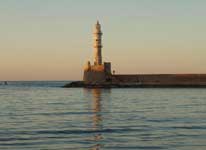
The modern city
The marina in the old harbour.
The modern part of Chania is where most locals live and work. It is less traditional than the old town, but there are still areas of charming beauty or of some historical interest. The oldest district (early 18th century) of the modern city is Nea Hora (meaning "New Town") which is located beyond the west end of the old town. It is a developing area, but also a very picturesque one, with narrow old lanes leading to a small fishing harbour. During the same era the district of Halepa begun to grow to the east of the city and used to be home for the local aristocracy. Some of the historical buildings of the area (including old embassies of foreign countries) had been destroyed or abandoned during the later decades of the 20th century, and it was only recently when some interest was shown for the restoration of the remaining ones.
The lighthouse of the city.
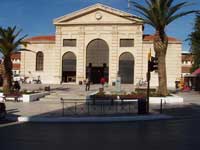
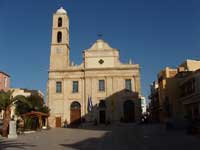
The Orthodox Cathedral.
Inside the Orthodox Cathedral.
Other historical buildings in the area include Eleftherios Venizelos’s House (built 1876-1880), the old French school (now property of the Technical University of Crete, housing the Department of Architecture), the Church of Agia Magdalini (built 1901-1903), The “Palace” (built 1882, house of Prince George during the period of the Cretan independence) and The Church of Evangelistria (built 1908-1923). Part of the marine area of Halepa is called Tabakaria, where a unique architectural complex of old leather processing houses is situated. The district of Koum Kapi (the Venetians had first named it "Sabbionara", which means "the Gate of the Sand", the same as "Koum Kapi") situated beyond the walls at the eastern part of the old town, was also one of the first places to be inhabited outside the fortification walls. Initially, it was home for the "Halikoutes", a group of bedouins from North Africa who had actually settled there since the last years of the Turkish occupation. Nowadays it is a developing area with many trendy cafes, bars and restaurants on its picturesque beach.
Apart from the previously mentioned older districts of the modern part of the town, several new residential areas have been developed during the 20th century, like Agios Ioannis, Koumbes, Lentariana etc. Some part — but not the biggest — of the city centre is dominated by colourless medium-height block buildings, typical of the urbanization period of Greece (1950–1970). However, there are still some beautiful neoclassical houses especially at the eastern part of Chania and some of the neighbourhoods surrounding the centre are quite picturesque. The plan of the central area is very good, there are some nice parks and several sports grounds, the most important being the Venizeleio Stadium of Chania and the Swimming Pool at Nea Hora. The 1913 indoor market ("Agora"), a large building based on the market of Marseille, is on the edge of the old town and is popular with tourists and locals alike. Some other important sites of the newer urban area are The Court House ("Dikastiria", built late 19th century), The Public Gardens ("Kipos", created 1870), The Garden Clock-Tower ("Roloi", built 1924-1927), The Episcopal Residence (Bishop's residence, "Despotiko", built early 19th century) and the House of Manousos Koundouros (built 1909), the Cultural Centre ("Pnevmatiko Kentro"). The central largest squares in Chania are the Market Square ("Agora"), the Court House Square ("Dikastiria") and the "1866 Square".
In the last two decades there has been a profound movement of Chania residents towards the suburbs, as well as towards areas around the city which used to be rural, mainly the Akrotiri Peninsula.
Click image to enlarge
Chania, Clock-Tower Google Earth
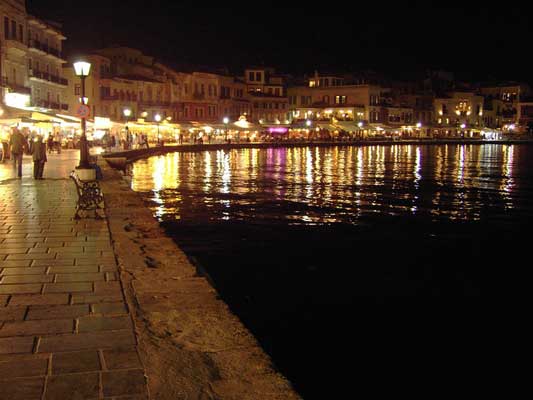
Harbour of Chania city [Source]
The church of St.Rocco in Splantzia
Baroque style church in eastern Chani
Court House Square (Dikastiria)
The Episcopal residence
Culture
A snapshot from a cultural event in Chania.
The cultural background of Chania is very rich, first of all due to the town's long history and its interaction with many diverse civilizations in the past. Furthermore the location of Crete (immediately connected to Athens, situated between Europe, Asia and Africa) as well as the cosmopolitan atmosphere that tourism creates, have generally kept the town up-to-date with modern advances in art and knowledge. Currently, there are several museums, art galleries, theatre and music groups, educational and research institutions within the city.
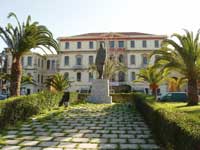
Chania , Court House with Eleftherios Venizelos Statue,
The most important museums in Chania are:
Archeological Museum of Chania in Saint Francis Monastery. It houses findings from different parts of the county and from several historical and prehistorical periods of the local history (Neolithic to Roman)
Folklore Museum (Old Town)
Historical Archive[5] (the second most important in Greece)
Nautical Museum of Crete (Old Town)
Municipal Art Gallery [1]
Byzantine/Post-Byzantine Collection (Old Town)
House of E. Venizelos [2]
War Museum
Museum of Chemistry
School life museum
Part of the "Mediterranean Centre for Architecture".
Several theatre groups are active in Chania with the most important being the Municipal and Regional Theatre of Crete (DI.PE.THE.K) [3]. The repertoire includes old and contemporary plays from Greek and foreign writers. The Venizelian Conservatory of Music ("Odeion", established 1931) is also one of the most important cultural societies in Crete. A recent attempt from the municipality to create a chamber music group named "Sinfonietta" has been successful and its performances throughout the year have enriched the cultural event calendar of the city. There is also a significant community of people who focus on alternative/indie music as well as jazz and some interesting bands performing modern musical styles. A number of traditional [Cretan] musicians are also active in town.
The city is also quite cinephile. There are five cinemas (two of them open-air), concentrating both in commercial and independent movies and occasionally organizing small festivals.
During the summer period a variety of cultural events take place on a daily basis. Theatrical plays, concerts and several exhibitions from Greek and foreign artists are organized either by the municipality or by individuals. A venue which hosts many of these events is a theater located in the east bulwark of the Old Town ("Anatoliki Tafros"). Also, several festivals, conferences or sport events take place in Chania especially between May and September. The Venizeleia athletics competition is one of the most noteworthy events of the year.
Cultural life throughout the wintry period of the year (November–March) is not as rich as in the summer, but it is certainly maintained to a good standard. During the last years there has been a substantial effort by both the city councils and by the locals to create the background for the city to be in the centre of interest throughout the year. Towards this direction, the increasing number of students moving to Chania for their studies has proved to be helpful. There is also some effort to promote Crete as a tourist destination for all seasons — a role that the island could easily hold — which would also support both the local economy and culture.
A major role in the city's cultural life is played by the Municipal Cultural Corporation of Chania (DI.P.E.X.) [4] which organizes a significant part of the events taking place throughout the year.
There is a French, a German, an Italian and a Swedish consulate in Chania.
Sports
The Municipal Stadium of Chania.
Water sports are very popular in Chania and especially the local water polo team (Nautical Club of Chania, N.O.X. [5]) has managed to be a protagonist in the primary league of the Greek national championship for years. Several athletes of this team have also played extensively for the Greek national team which has achieved major international successes.
Football and basketball are also very popular in the town, however not as successful. The main football teams are "A.O.X" (Sports Club of Chania). and "Ionia". The main clubs for athletics are "Eleftherios Venizelos" and "Kydon". The "Antisfairisi" club is specialized in tennis and table tennis and has also a significant tradition in chess. Many of the above sports are being practiced in the National Stadium of Chania, constructed in 1935 with the financial support of Elena Venizelou, then wife of Eleftherios Venizelos. There is also an open swimming pool for water sports in Nea Chora and a new indoor one which is being built on the nearby Akrotiri Peninsula. A modern indoor stadium for basketball / volleyball etc. has also been built (2002–2005) near Nea Chora (Kladisos area).
It also has to be mentioned that there is a very active climbing / mountain walking club (Greek Mountaineering Club of Chania, E.O.S. Chanion [6]) organizing weekly excursions of varying difficulty on the mountains of Crete and several other longer term missions in mainland Greece and abroad.
Education/Research
The Library of the Technical University of Crete.
Educational institutions located at the greater area of the city are:
The Technical University of Crete [7]. It is the largest educational institution in Chania with around 2600 undergraduate and 700 postgraduate students. It is focusing on Electronic and Computer Engineering, Environmental Engineering, Production Engineering and Management, Mineral Resources Engineering, Sciences and Architecture. Future plans include a Civil Engineering and a Fine Arts department.
The Chania branch of the Technological Educational Institute of Crete [8]
The Mediterranean Agronomic Institute of Chania [9]
Other research and intellectual institutes and societies in Chania are:
The National Research Foundation "Eleftherios K. Venizelos" [10]
The Mediterranean Architecture Centre (KAM) [11]
The Institute of Olive Tree and Subtropical Plants of Chania [12]
The Institute of Cretan Law
The Historical, Laographical and Archaeological Society of Crete
Primary and secondary schools are mainly public in Chania (as in all cities in Greece). However there has been a slow development of some private high schools recently. Among the "Eniaia Lykeia" (Unified Upper Secondary Schools) of the town there is an autonomus Ecclesiastical Lyceum in Agios Mattheos.
Economy
The central Market Square ("Agora").
Sponges on sale in Agora.
Two main sources of wealth in Chania are agriculture and tourism. A big portion of the city's residents (not necessarily farmers) own from few to many decares of agricultural land where several plants are being cultivated, the most popular ones being olive trees and citrus. Other important products include wine, avocados, dairy etc. Apart from the traditional ways of cultivation, some of the producers have concentrated on practicing new methods in order to promote organic food. The organization of the Agricultural August [13] has been a recent attempt to promote local quality products including a series of activities organised by the Prefecture of Chania since 1999 and has proved very successful.
On the other hand, tourism has developed rapidly during the last decades, starting from the early 1970s. Nowadays the tertiary sector is becoming more and more important for the locals, since an increasing number of them are participating in the business. Agrotourism and ecotourism are forms of tourism which are significantly developing lately.
There is also some secondary industry with focus on the processing-packaging of the agricultural products (some of them export oriented) or manufacture products that support the agricultural production. On the other hand, the growth and development of academic/research institutions in Chania is a challenge for future economic activities by taking advantage of the specialised knowledge of scientists and technicians and by also reinforcing quality tourism (conferences etc.).
An important centre of the economic activities in the town is the Chania Chamber of Commerce and Industry (E.B.E.X.) [14].
Health care
The main health center in the city is the General Hospital "Agios Georgios". Other institutions include the Crete Naval Hospital, the branch of the National Centre for Emergency Medical Care (E.K.A.B.) and the Clinic of Chronic Disease. The Chania branch of the Organisation Against Drugs (Ο.ΚΑ.ΝΑ.) opened in 2003.
There is also a number of private clinics and medical centers specializing in various areas within the town.
Transportation
Aerial view of Chania International Airport.
The city is served by Chania International Airport (IATA code: CHQ) on the Akrotiri Peninsula. The airport is named after Daskalogiannis, a Sfakiot hero who was skinned by the Turks in the 18th century.
There are several flights a day from Athens to Chania, with Aegean Airlines and Olympic Airlines. From April-early November, there are many direct charter flights to Chania from the United Kingdom, Germany, Scandinavia, the Netherlands and other European countries.
Souda, some 7 km (4.3 mi) from Chania, is the city's port, with daily ferries to Piraeus and a NATO naval base.
Notable residents
Elpis Melena 1818-1899 (born as Marie Espérance von Schwartz, German writer)
Eleftherios Venizelos 1864-1936 (prime minister of Greece 1910-1920, 1924, 1928–1932, 1933; widely considered as the most important statesman of modern Greece)
Constantinos Manos 1869-1913 (politician and writer of the late 19th and early 20th century)
Alexis Minotis 1898-1967 (famous stage and screen actor active between 1930s-1980s)
Manos Katrakis 1909-1984 (famous theater and film actor)
Constantine Mitsotakis *1918 (politician, prime minister of Greece 1990-1993, now the honorary president of the New Democracy party)
George Psychoundakis 1920-2006 (Cretan war hero and author)
John Craxton 1922-2009 (painter and British hon. consul.)
Kostas Moundakis 1926-1991 (Traditional Cretan music composer, Cretan lyra virtuoso and teacher)
Eftichios Bitsakis *1927 (philosopher – theoretical physicist)
Maro Douka *1947 (Greek novelist)
Ioanna Karystiani *1952 (Greek novelist)
Phocion Francescakis 1910-1992, Private international law's teacher
International relations
See also: List of twin towns and sister cities in Greece
Chania is twinned with:
Cyprus Paphos, Cyprus
New Zealand Wellington, New Zealand
See also
List of settlements in the Chania regional unit
Mount Tityros
Cretan diet
References
^ Google map showing main road distance from Chania to Falasarna
^ "Climatological Information for Khania, Greece". Hong Kong Observatory. Government of Hong Kong Special Administrative Region. August 15, 2011. Retrieved March 31, 2012.
^ "Government Gazette (2nd Ed)" (in Greek). Greece Ministry of Interior. August 11, 2010. Retrieved March 31, 2012.
^ Hogan, C Michael (January 23, 2008). "Cydonia". The Modern Antiquarian. Retrieved March 31, 2012. "Cydonia is one of the five great cities of Minoan Crete, although exact location of the ancient city was not even resolved until the latter half of the 20th century. The most powerful center of western Crete, Cydonia produced Bronze Age pottery and Linear B writings circa 1700 to 1500 BC, and was one of the first cities of Europe to mint coinage. A temple of Britomartis was erected on Mount Tityros near the city. HISTORY Cydonia was likely established as a Neolithic settlement in the fourth millennium BC. Archaeological excavations in the old town of present day Chania have revealed the remains of Middle Minoan Period Cydonia. These explorations are difficult, since the entire Venetian city of Chania was developed over Cydonia, with virtually no recorded medieval or modern mention of the ancient city specifics until the first finds in 1965. (Andreadaki,) Ancient mention of the civilization in Cydonia is also made by Polybius, Strabo, Scylax and by Hanno in the Periplus. (Smith, 1878) Interestingly Pashley was able to work out rather accurately the location of ancient Cydonia without any archaeological data; he deduced the location near the port and Old Town from passages in the classical literature. (Pashley, 1837)"
^ Historical Archive of Crete
|
Divisions of the Chania prefecture Provinces of the Chania prefecture Apokoronas | Kissamos | Kydonia | Selino | Sfakia Municipalities of the Chania prefecture Akrotiri | Anatoliko Selino | Armeni | Chania | Eleftherios Venizelos | Fres | Georgioupoli | Innachori | Kandanos | Keramia | Kissamos | Kolymvari | Kryonerida | Mousouri | Mythimna | Nea Kydonia | Pelekanos | Platanias | Sfakia | Souda | Theriso | Vamos | Voukolies Non-municipal communities of the Chania prefecture |
| Ancient Greece
Science, Technology , Medicine , Warfare, , Biographies , Life , Cities/Places/Maps , Arts , Literature , Philosophy ,Olympics, Mythology , History , Images Medieval Greece / Byzantine Empire Science, Technology, Arts, , Warfare , Literature, Biographies, Icons, History Modern Greece Cities, Islands, Regions, Fauna/Flora ,Biographies , History , Warfare, Science/Technology, Literature, Music , Arts , Film/Actors , Sport , Fashion --- |
Retrieved from "http://en.wikipedia.org/"
All text is available under the terms of the GNU Free Documentation License


